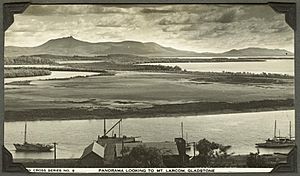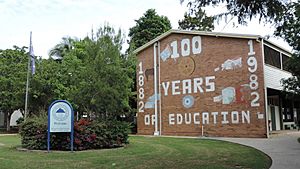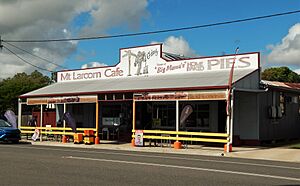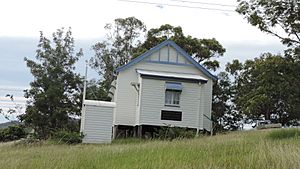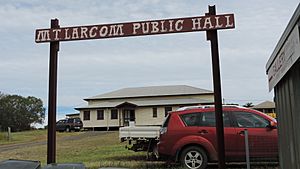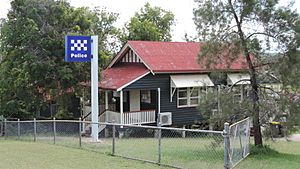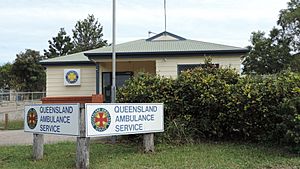Mount Larcom, Queensland facts for kids
Quick facts for kids Mount LarcomQueensland |
|||||||||||||||
|---|---|---|---|---|---|---|---|---|---|---|---|---|---|---|---|
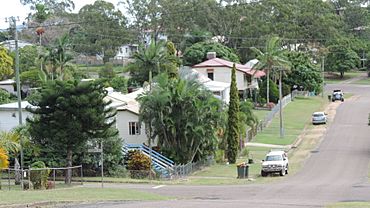
Gladstone Street, 2014
|
|||||||||||||||
| Population | 332 (2021 census) | ||||||||||||||
| • Density | 3.938/km2 (10.20/sq mi) | ||||||||||||||
| Postcode(s) | 4695 | ||||||||||||||
| Area | 84.3 km2 (32.5 sq mi) | ||||||||||||||
| Time zone | AEST (UTC+10:00) | ||||||||||||||
| Location |
|
||||||||||||||
| LGA(s) | Gladstone Region | ||||||||||||||
| State electorate(s) | Gladstone | ||||||||||||||
| Federal Division(s) | Flynn | ||||||||||||||
|
|||||||||||||||
Mount Larcom is a small town and a mountain in the Gladstone Region of Queensland, Australia. It's a rural area, meaning it's mostly countryside with farms and open spaces. In 2021, about 332 people lived in the Mount Larcom area.
Contents
What is Mount Larcom Like?
The town of Mount Larcom is located in the southwestern part of the area. It sits where the Bruce Highway meets the Gladstone–Mount Larcom Road. This spot is about 70 kilometers (43 miles) south of the city of Rockhampton.
The mountain itself, also called Mount Larcom, is about 10.8 kilometers (6.7 miles) east of the town. It stands tall at 632 meters (2,073 feet) high. Even though it's not right next to the town, you can easily see it from far away, especially from the city of Gladstone.
Other Mountains in the Area
Besides Mount Larcom, there are a few other smaller mountains nearby:
- Bottle Tree Hill, which is 120 meters (394 feet) high.
- Curley, standing at 264 meters (866 feet) high.
- Limestone Hill, which is 110 meters (361 feet) high.
How to Get Around
The North Coast railway line runs through the Mount Larcom area. There's a train station right in town called Mount Larcom railway station. This train line helps connect Mount Larcom to other places.
A Look Back in Time
Mount Larcom has a long history, starting with its name.
Naming the Mountain
The mountain was named by Commander Matthew Flinders on August 4, 1802. He named it after his friend, Captain Thomas Larcom, who was in the Royal Navy. For many years, the area was spelled "Mount Larcombe," but it changed back to "Mount Larcom" in the early 1900s.
Early Settlement and Challenges
In 1854, the British government made the land around Mount Larcom available for pastoral farming, which is raising sheep or cattle. The next year, a Scottish settler named William Young started a sheep farm called Mount Larcombe station.
During this time, there were conflicts between the British settlers and the Aboriginal people who originally lived on the land. William Young sometimes traded with the local Aboriginal people, giving them food and clothes for their land and help with his sheep. However, there were also sad and difficult times. In 1855, some Aboriginal people were killed by police at Mount Larcombe. Later, in revenge, some station workers were killed. This led to more violence and tracking down of Aboriginal groups. Similar sad events happened again in 1858.
Schools and Services Grow
- First School: Mount Larcombe Provisional School opened on November 13, 1882. It later became Mount Larcom State School in 1913. In 1964, it started teaching older students up to Year 10.
- Post Office: The Mount Larcom Post Office opened in 1909, making it easier for people to send and receive mail.
- Another School: Butlerville State School opened in 1918 but closed a few years later.
- Community Gatherings: The first annual agricultural show in Mount Larcom was held in 1919. These shows are still a big event today.
- Churches: All Saints Anglican Church opened in 1921, and the Catholic church, Our Lady of Mount Carmel, opened in 1922.
- Emergency Services: An ambulance station first opened in 1924, helping people in emergencies. A new one was built in 2001.
- Library: The Mount Larcom library building opened in 2004, giving people a place to read and learn.
Who Lives in Mount Larcom?
The number of people living in Mount Larcom has changed over the years:
- In 2011, there were 278 people.
- In 2016, the population grew to 361 people.
- In 2021, the population was 332 people.
Important Places to See
Mount Larcom has some places that are important to its history:
- The original site of the Mount Larcombe Station Homestead on Bruce Highway.
- The Mount Larcom Cemetery on Popenia Road.
- The Mount Larcom Showground on The Narrows Road.
Getting Around Mount Larcom
The Mount Larcom railway station is part of the North Coast railway line. You can catch long-distance passenger trains here, and there's a direct line to Gladstone.
Learning in Mount Larcom
Mount Larcom State School is a school for both primary (Prep-Year 6) and secondary (Years 7-10) students. It's located on Raglan Street. In 2018, the school had 73 students and 12 teachers.
For students who want to continue their education up to Year 12, the closest high school is Gladstone State High School in West Gladstone.
Community Life and Services
Mount Larcom has several important services and places for its community.
Local Facilities
- The Mount Larcom Library is on Raglan Street and is run by the Gladstone Regional Council.
- Our Lady of Mount Carmel Catholic Church is at 16 Balfour Street. They have a mass and a special service led by church members each month.
- All Saints Anglican Church is at 57 Raglan Street.
- There's a public hall on Raglan Street, which is used for community events.
Emergency and Support Services
Even though it's a small town, Mount Larcom has important emergency services:
- A police station on Gladstone Street.
- An ambulance station on Raglan Street.
- A volunteer Rural Fire Service to help with fires.
- A volunteer State Emergency Service (SES) group for other emergencies.
The closest hospitals are in Gladstone and Rockhampton. Because Mount Larcom is near two highways, emergency services often respond to vehicle accidents.
The Mount Larcom branch of the Queensland Country Women's Association (QCWA) meets at 4 King George Street. This group helps women in rural areas and supports the community.
Fun Events
The Mount Larcom and District Show Society organizes an annual agricultural show every June. It's a big event with lots of activities! In 2014, besides the usual farm animal competitions, there were also fun things like a ute muster (a competition for utility vehicles), woodchopping, and fireworks.



